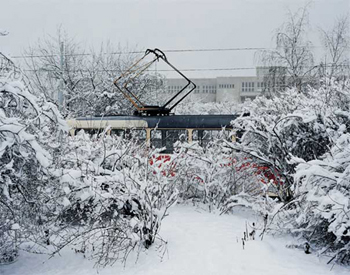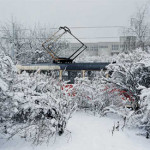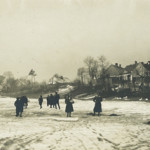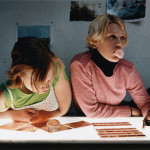By SHANE LAVALETTE
The following interview is a conversation between Shane Lavalette and photographer Matthew Monteith, discussing Czech Eden, published by Aperture in 2007, with photographs by Monteith. Their discussion also touches on photography's various uses to define identity and history. Shane spoke with Matthew in February of 2008. - Ed.
•
Shane Lavalette: What is your earliest memory of looking at a photograph and understanding it as more than just a “document,” as a medium for artistic expression? How did your interest in photography develop after this?
Matthew Monteith: I’m not sure I ever thought of photographs as documents. I started photographing when I was 12 and my initial attraction was aesthetic. I thought cameras and the gadgetry of film were cool: everything had an order, a purpose, and a place. I liked the way the photograph rendered the world, the uniformity of it. There is something about parsing everything down into a visual language, where everything is compressed. I could create the world I wanted to see by editing the images into something that didn’t really exist, but I wished did.
SL: While turning the pages of Czech Eden, I feel as though I can make my own speculations about which photographers you might admire. I’m curious to hear from you, though; what photographers or books got you most excited about photography before you were making work yourself? And now?
MM: This question is difficult to answer because my first influences were accidental, books I happened to come across in a library or store. The first photography book I owned, by Arnold Newman, was given to me. I saw a Paul Strand exhibit with my father at the Art Institute of Chicago when I was 15 and around the same time, Margaret Bourke-White’s images made me think of photography as something that enabled someone to explore great places, things of significance. The most seminal early books for me though were Brassai’s Paris de Nuit and John Szarkowski’s Looking at Photographs. At one point, I became obsessed with Andy Warhol and The Factory. A bit later, I discovered Walker Evans, Eugene Atget, Stephen Shore, William Eggleston, Harold Edgerton, Edward Hopper, and Richard Misrach. I also worked for Mitch Epstein in my early to mid-twenties.
Some of the artists and projects that I have been thinking about recently: Tim Davis’ My Life in Politics, John Pilson’s Interregna, Martin Parr, Adam Fuss, Luigi Ghirri, and Tom Sachs.
SL: When did you first visit the Czech Republic? What inspired you to begin making photographs there?
MM: I first went to the Czech Republic in the fall of 1991 to visit a family friend who was teaching English in Ústí nad Labem. I had been traveling around Europe, and the Czech Republic made the biggest impression on me. I came back for a few months after I graduated from high school and then again in 1996, spending 5 months in Pardubice, an industrial town in Eastern Bohemia. At that time, I put together a book called Uncertain History, mixing my own images with found photographs.
SL: How did this evolve into what would become Czech Eden?
MM: While making Uncertain History, I became captivated by how images take on meaning based on the sequence, order, and relationship to each other. I returned in 2001 with the idea of creating a fictional portrait of a place that exists only by editing reality. The photographs that became Czech Eden were made over 11 months from September of 2001 to July of 2002, while I was living in Prague on a Fulbright Fellowship.
SL: I understand that you were also very inspired by postcards from Czechoslovakia’s communist era. In what way did those influence the work?
MM: These postcards were found in antique stores and came from the brief period between the two World Wars when the Czechs had independence. There were aesthetic concerns in the photographs that heavily influenced me: the way the pictures were composed, the way the postcards said something about how the people wanted to be depicted and/or perceived. But also, these cards showed an idyllic world, ringed by modern realities. Looking back from the perspective of the early 1990’s, I was aware of a world about to end, of the impending German invasion and the subsequent takeover by the Communists. These cards were meant to be perceived one way at the time they were produced, but I, as a viewer, couldn’t help but see them through the filter of history and what happened next.
When I returned to the Czech Republic in 2001, the country was again coming to terms with the outside world at their door, and how they would negotiate becoming a part of Europe while maintaining their Czech identity. I was interested in exploring the boundary between outside knowledge and a once hermetically sealed world attempting to maintain its unique identity in the face of change.
SL: How would you say your own photographs move beyond “travel photographs” or what Susan Sontag has referred to as “the indisputable evidence that the trip was made?” How is and, more importantly, how isn’t Czech Eden a documentary project?
MM: The question of believability in photography intrigues me: of what is reality and what is created. Photography is subjected to the misconception that a photograph depicts what is, rather than what was seen. Much as a fiction writer describes a world that is recognizable and true, yet made up, the story is a fabrication based on a reality. I hope Czech Eden is understood in this manner. You might be able to find pieces of what I have described in the pictures of places and people, but the subjects would appear altogether different if you traveled to the Czech Republic. “Documentary” attempts to record an actuality. The photographs in the project, while made from the real world, are subjective and put in an order meant to create something independent, something that is not merely referential, or rooted in reality. Also, I intended the book as an allegory and as such, I hope it says something about society and humanity in general, and is not just about the Czech Republic.
SL: In the introduction to your book, renowned Czech novelist Ivan Klima writes, “Taking photographs in a foreign country is always enticing but also difficult… Naturally you are tempted to succumb to the attraction, even the exoticism of the unknown.” Is this something you had to deal with while making the photographs or is succumbing to the exoticism of the unknown part of your intention?
MM: I was interested in exploring the notion of utopia and the consequences of trying to create it, but I was also curious about what I would find by being there. The Czech Republic has a history of social experiments, so I was looking at that history while being open to what was unfolding around me. That history was a background, a jumping off point, but not the point of the work.
SL: What, then, is your expectation for those looking at the photographs? Is the book form (and sequence) ideal for viewing the work?
MM: I hope Czech Eden does say something about paradise and fairytales, human nature and a desire for a hermetically sealed environment, the dichotomy of beauty and darkness. But ultimately, I don’t think you can say or expect how people will view your work. Obviously I had an intention and purpose in making the book, but once it is out in the world, viewers create their own engagement with it. My view of the work changes in time as I see the perceptions of others to the work and as I change as an artist, so I don’t have a fixed expectation.
The book format is my favorite way to look at photographs in general because books are accessible: all you need is a library or bookstore; you don’t necessarily need money or have to live in a close proximity to the art world. Books are intimate because the viewer can sit alone with a book, flip through it, study it, come back later and revisit it.
SL: That gorgeous photograph of the couple wading in water, the woman cradling her naked baby, is among my favorites from the book. Can you tell me how you see the portraits fitting into project?
MM: The portraits are a part of the world I was trying to describe. Some of the subjects are friends of mine, some are complete strangers I encountered or brief acquaintances I had while living in Prague. My relationship to the subjects is unimportant though; what matters is how viewers experience the book. The portraits are not meant to be accurate representations of people, but rather pieces of a larger whole.
SL: Is the reception of your work different in the Czech Republic than in America? Or have you encountered the same reactions to it?
MM: There has been very little reaction in the Czech Republic, perhaps because it isn’t widely distributed there and perhaps because I am an outsider. I was impressed with Ivan Klima’s response to the work because we never met, so he wrote the introduction based completely on the images. The only input I gave to him was that my intention was not to create a portrait of place, but rather present a fiction or allegory from it. The only Czech press coverage I know of was in the English language paper for ex-pats, The Prague Post.
SL: While working on his Niagara project, Alec Soth drove around in his car with quotes from Nabokov’s Lolita and a list of potential subjects he wanted to photograph taped to his steering wheel. Was there ever a point where you had such a specific idea of what you were looking to photograph for the project? Did you ever find yourself searching for particular images to convey a particular meaning?
MM: Sure, I was looking for places or things I had an attraction to in that I would see a picture or read something and then go seek the place out, but the actual body of work is the result of what I found along the way. More often then not the original idea would lead to something else.
SL: I understand the title, Czech Eden, was inspired by your visit to Český ráj, a protected park in the Czech Republic whose name literally translates to Czech “Heaven,” “Paradise,” or “Eden.” Interestingly, Klima identifies a quality of loneliness in your work, suggesting that your photographs are “like a tour of the world as perceived [by Kafka]” – hardly reminiscent of a paradise. For what reason did you choose to title the project with this name?
MM: Český ráj is a national park in Northern Bohemia, very close to industrial towns and some of Europe’s largest coalmines. It is an unexpected setting full of strange rock formations and castles. It became a representation of the country to me: an oddly surreal, fairy tale landscape surrounded by the ugliness created from the Industrial Revolution and the Soviets. The word Paradise comes from the Persian word for enclosed garden, so Paradise is inherently isolated, enclosed by a wall. Back to the idea of Utopia; people seeking perfect places are looking to get back to Eden, to return to a state of before the fall, but if the Garden of Eden was so idyllic, Eve would not have pulled the fruit off the tree and risked losing her place in the garden.
SL: What draws you to this line between reality and the idyllic?
MM: To me, it is more than a line, and exists as a space in need of exploration, a whole other world. Photography appears to depict reality with precision, but is, at the same time, a subjective view or an alteration of reality. By exploring this relationship, I learn about the way the world works, how things are put together. As Garry Winogrand said, “I photograph to see what things look like photographed.” This quality is what makes the work of Andreas Gursky, Vic Muniz, and Thomas Demand interesting to me. They explore the issues of photographic truth in ways that underscore photography as a medium that is often misunderstood.
SL: How do you feel your other projects, both preceding and following Czech Eden, are connected? In other words, can you identify an underlying thread that runs through all of your work?
MM: I am interested in ways that humanity sequesters itself. We create isolated realms in order to exert control or to create a falsely ideal environment. Whether it is an art school, an attempt at social utopia, or a car designed to further separate its passengers from the reality of the places being passed through, I see the world growing smaller and larger at the same time. As we become increasingly global, with unprecedented access to difference and to information, there seems to be a desire for boundaries and walls to keep the world, and therefore understanding, at bay.
SL: Do you view your Art School project as a critique of the role of such institutions in the arts? How has your approach been shaped or affected by your own experience with art schools, having studied at both ICP and the MFA program at Yale?
MM: Art school is an absurd place and yet wonderful. On the one hand, it is a vacuum where students work on their projects in a Petri dish, which enables work to be made, examined, and developed. But, in isolation and without the balance of the reality, people can take themselves too seriously and their work not seriously enough. It can be fraught with contradictions in that students are asked to create something unique for critique, but that work can be shot down by a limited audience with a particular agenda, which can lead to a homogeneous body of work. I am looking at both what works and what doesn’t. Art school gives you invaluable time and space, but the space itself is artificial in that it is isolated and not of the real world.
SL: What are you working on now?
MM: A handful of projects relating in one way or another to contemporary America’s increasing insularity. I am trying to make work – such as the car pictures or the televisions – that address these issues of paradise, tuning out, a muting of experience. There is an element of the pictures that is clearly American, but I don’t want the work to be just about America. The trends I am looking at of consumption, desire, knowledge, and subjugation are global. Our isolation here, our tuning out of realities, doesn’t make reality go away: it exists outside the boundary, beyond the line we allow ourselves to see.
- Matthew Monteith, Number 5 Tram, Olšanské Hřbitovy, March, 2002 (from “Czech Eden”), 2002
- Anonymous Czech postcard, produced between the First and Second World Wars.
- Matthew Monteith, At the Lightbox (from “Art School”), 2004
This interview was originally posted by Shane Lavalette on his blog, which features discussions on fine art photography, current exhibitions, books, films, and interviews with artists.
Matthew Montieth
Shane Lavalette / Journal
"Czech Eden" with photographs by Matthew Monteith, and essay by Ivan Klima, was published in by Aperture in 2007
All images are courtesy of the artist; interview transcript courtesy of the author.







